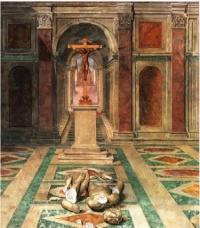Christianity and paganism
From The Art and Popular Culture Encyclopedia
|
"The poor wretches [Christians] have convinced themselves, first and foremost, that they are going to be immortal and live for all time, in consequence of which they despise death and even willingly give themselves into custody; most of them. Furthermore, their first lawgiver persuaded them that they are all brothers of one another after they have transgressed once, for all by denying the Greek gods and by worshipping that crucified sophist himself and living under his laws. Therefore they despise all things indiscriminately and consider them common property, receiving such doctrines traditionally without any definite evidence. So if any charlatan and trickster, able to profit by occasions, comes among them, he quickly acquires sudden wealth by imposing upon simple folk." --Lucian, The Death of Peregrine |

|
Related e |
|
Featured: |
This article provides an overview of the relations between Christianity and its adherents vs pagan religions and their adherents from the early Christian era.
Early Christianity developed in an era of the Roman Empire during which many religions were practiced, that are, due to the lack of a better term, labeled paganism. "Paganism" in spite of its etymological meaning of "rural" in the context of early Christianity has a number of distinct meanings. It refers to the Greco-Roman religions of the Roman Empire period, including the Roman imperial cult, the various mystery religions as well as philosophic monotheistic religions such as Neoplatonism and Gnosticism as well as the "barbarian" tribal religions practiced on the fringes of the Empire. From the point of view of the early Christians these religions all qualified as "ethnic" (or "gentile", ethnikos, gentilis, the term translating goyim, later rendered as paganus) in contrast with Judaism. Since the Council of Jerusalem, the Christian apostles accepted both Jewish and pagan converts, and there was a precarious balance between the Judaizers, insisting on the obedience to the Torah Laws by all Christians, on one hand, and Pauline Christianity, developed in the gentile missionary context, on the other.
Christianity during the Middle Ages stood in opposition to the "pagan" ethnic religions of the peoples outside the former Roman Empire, i.e. Germanic paganism, Slavic paganism etc.
See also
- Christian debate on persecution and toleration
- Christian views on magic
- Christianity and other religions
- Circumcision controversy in early Christianity
- Constantine I and Christianity
- Decline of Greco-Roman polytheism
- Germanic Christianity
- Panbabylonism
- Hellenistic philosophy and Christianity
- History of early Christianity
- Jesus Christ in comparative mythology
- Neoplatonism and Christianity
- Orthopraxy
- Persecution of Christians
- Christianity and astrology
- Virtuous pagan
- Witch-cult hypothesis

